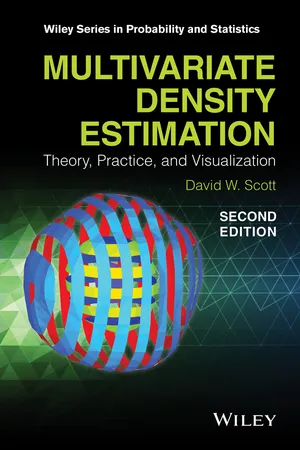
- English
- ePUB (mobile friendly)
- Available on iOS & Android
About This Book
Clarifies modern data analysis through nonparametric density estimation for a complete working knowledge of the theory and methods
Featuring a thoroughly revised presentation, Multivariate Density Estimation: Theory, Practice, and Visualization, Second Edition maintains an intuitive approach to the underlying methodology and supporting theory of density estimation. Including new material and updated research in each chapter, the Second Edition presents additional clarification of theoretical opportunities, new algorithms, and up-to-date coverage of the unique challenges presented in the field of data analysis.
The new edition focuses on the various density estimation techniques and methods that can be used in the field of big data. Defining optimal nonparametric estimators, the Second Edition demonstrates the density estimation tools to use when dealing with various multivariate structures in univariate, bivariate, trivariate, and quadrivariate data analysis. Continuing to illustrate the major concepts in the context of the classical histogram, Multivariate Density Estimation: Theory, Practice, and Visualization, Second Edition also features:
- Over 150 updated figures to clarify theoretical results and to show analyses of real data sets
- An updated presentation of graphic visualization using computer software such as R
- A clear discussion of selections of important research during the past decade, including mixture estimation, robust parametric modeling algorithms, and clustering
- More than 130 problems to help readers reinforce the main concepts and ideas presented
- Boxed theorems and results allowing easy identification of crucial ideas
- Figures in color in the digital versions of the book
- A website with related data sets
Multivariate Density Estimation: Theory, Practice, and Visualization, Second Edition is an ideal reference for theoretical and applied statisticians, practicing engineers, as well as readers interested in the theoretical aspects of nonparametric estimation and the application of these methods to multivariate data. The Second Edition is also useful as a textbook for introductory courses in kernel statistics, smoothing, advanced computational statistics, and general forms of statistical distributions.
Frequently asked questions
Information
1
REPRESENTATION AND GEOMETRY OF MULTIVARIATE DATA
1.1 INTRODUCTION
Table of contents
- COVER
- TITLE PAGE
- TABLE OF CONTENTS
- PREFACE TO SECOND EDITION
- PREFACE TO FIRST EDITION
- 1 REPRESENTATION AND GEOMETRY OF MULTIVARIATE DATA
- 2 NONPARAMETRIC ESTIMATION CRITERIA
- 3 HISTOGRAMS: THEORY AND PRACTICE
- 4 FREQUENCY POLYGONS
- 5 AVERAGED SHIFTED HISTOGRAMS
- 6 KERNEL DENSITY ESTIMATORS
- 7 THE CURSE OF DIMENSIONALITY AND DIMENSION REDUCTION
- 8 NONPARAMETRIC REGRESSION AND ADDITIVE MODELS
- 9 OTHER APPLICATIONS
- APPENDIX A: COMPUTER GRAPHICS IN ℜ3
- APPENDIX B: DATASETS
- APPENDIX C: NOTATION AND ABBREVIATIONS
- REFERENCES
- AUTHOR INDEX
- SUBJECT INDEX
- WILEY SERIES IN PROBABILITY AND STATISTICS
- END USER LICENSE AGREEMENT